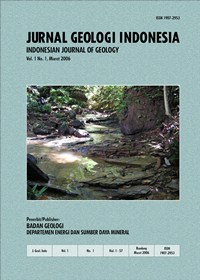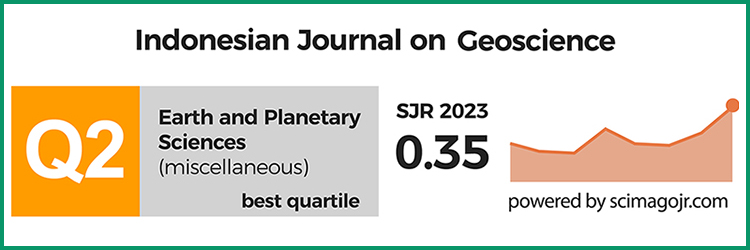Characterization of volcanic deposits and geoarchaeological studies from the 1815 eruption of Tambora volcano
DOI:
https://doi.org/10.17014/ijog.1.1.49-57Keywords:
plinian eruption type, pyroclastic surge, pyroclastic flow, pyroclastic airfall, geoarchaeology, GPR, ancient villageAbstract
https://dx.doi.org/10.17014/ijog.vol1no1.20066a
The eruption of Tambora volcano on the island of Sumbawa in 1815 is generally considered as the largest and the most violent volcanic event in recorded history. The cataclysmic eruption occurred on 11 April 1815 was initiated by Plinian eruption type on 5 April and killed more than 90,000 people on Sumbawa and nearby Lombok. The type plinian eruptions occurred twice and ejected gray pumice and ash, to form stratified deposits as thick as 40-150 cm on the slopes and mostly distributed over the district west of the volcano. Following this, at about 7 pm, on 11 April the first pyroclastic surge was generated and progressively became greater extending to almost whole direction, mainly to the north, west, and south districts from the eruption center. The deadliest volcanic eruption buried ancient villages by pyroclastic surge and flow deposits in almost intact state, thus preserving important archaeological evidence for the period. High preservation in relatively stable conditions and known date of the eruptions provide approximate dating for the archaeological remains. Archaeological excavations on the site uncovered a variety of remains were relieved by ground penetrating radar (GPR) to map structural remains of the ancient villages under the pyroclastic surge and flow deposits. These traverses showed that GPR could define structures as deep as 10 m (velocity 0.090 m/ns) and could accurately map the thickness of the stratified volcanic deposits in the Tambora village area.
References
Barberi, F., Bigioggero, B., Boriani, A., Cavallini, A., Cioni, R., Eva., C., Gelmini, R. Giorgetti, F., Iaccarino, S., Innocenti, F., Marinelli, G., Scotti, A., Slejko, D., Sudradjat, A., Villa, A., 1983, Magmatic evolution and structural meaning of the island of Sumbawa, Indonesia- Tambora volcano, island of Sumbawa, Indonesia. Abstract 18th IUGG I, Symposium 01, p.48-49.
Foden, J.D., 1986, The petrology of Tambora volcano, Indonesia: a model for the 1815 eruption. Jour. Volc. Geotherm. Res. 27, p.1-41.
Hamilton, W., 1979, Tectonic of the Indonesian region. US Geol. Surv. Prof. Paper, p.1-345.
Petroeschevsky, W.A., 1949, A contribution to the knowledge of the Gunung Tambora (Sumbawa). K.Ned. Aardrijksk Genoots Tijds 66, p.688-703.
Raffles, S.H., 1835, Memoir of the life and public services of Sir Thomas Stamford Raffles. Vol 1, Duncan, London, p.1-267.
Self, S., Rampino, M., Newton, M., Wolff, J., 1984, Volcanological study of the great Tambora eruption of 1815. Geology 12, p.659-663.
Sigurdsson, H., Carey, S., Cornell, W., Pescatore, T., 1985, The eruption of Vesivius in AD 79. Nat. Geogr. Res. 1, p.332-387.
Sigurdsson, H., Carey, S., 1989, Plinian and co-ignimbrite tephra fall from the 1815 eruption of Tambora volcano. Bull Volcanol 5, p.243-270.
Silver, E., Reed, D., McCaffrey, R., Joyodiwiro, Y., 1983, Back-arc thrusting in the eastern Sunda arc, Indonesia: a consequence of arc continent collision. Jour Geoph Res 88, p.7429-7448.
Slothers, R.B., 1984, The great Tambora eruption in 1815 and its aftermath. Science 224, p.1191-1198.
Takada, A., Yamamoto, T., Kartadinata, N., Budianto, A., Munandar, A., Matsumoto, A., Suto, S., Venuti, M.C., 2000, Eruptive history and magma plumbing system of Tambora volcano, Indonesia. Res. Volc. Hazr. Assess in Asia, ITIT Japan, p.42-79.



















